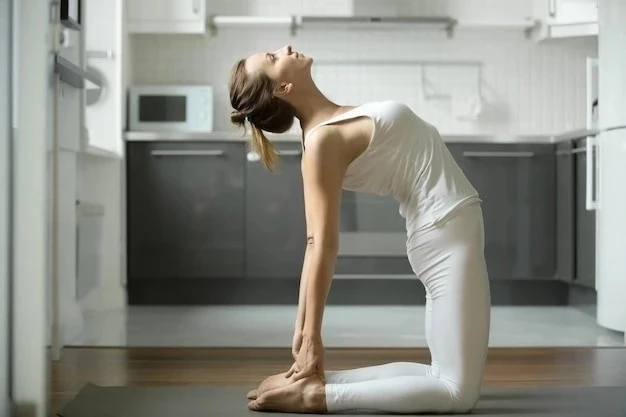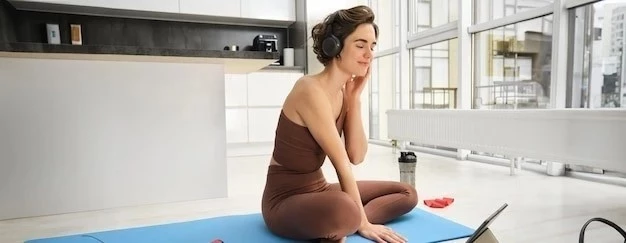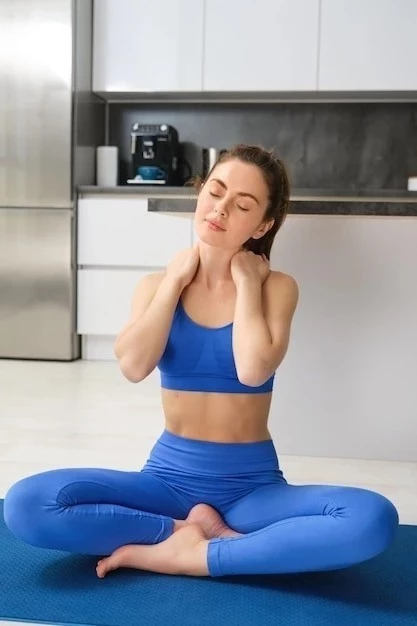Офисная работа часто приводит к напряжению в шее и плечах. К счастью, несколько простых асан йоги можно выполнять прямо на рабочем месте, чтобы снять это напряжение. Попробуйте позу кошки-коровы: плавно выгибайте и прогибайте спину, растягивая шею и плечи. Поза горки (легкий наклон вперед, сидя на стуле) поможет снять напряжение в верхней части спины. Не забывайте о позе расслабления плеч: медленно вращайте плечами вперед и назад, слегка наклоняя голову в разные стороны. Эти упражнения помогут улучшить кровообращение, расслабить мышцы и повысить концентрацию.
Важно помнить о правильной осанке во время работы за компьютером. Регулярное выполнение этих асан поможет избежать болей и дискомфорта, сохраняя вашу работоспособность и хорошее самочувствие на протяжении всего дня. Даже короткие перерывы на йогу – это залог вашей здоровья и продуктивности!
Асаны для улучшения осанки
Проводите большую часть дня сидя за компьютером? Тогда вам особенно важно уделять внимание своей осанке. Хорошая осанка не только улучшает внешний вид, но и способствует здоровью позвоночника, предотвращая боли в спине и шее. Йога предлагает множество асан, которые можно выполнять в офисе, чтобы укрепить мышцы спины и улучшить осанку. Даже несколько минут в день могут оказать заметное положительное влияние.
Адхо Мукха Шванасана (Собака мордой вниз): Хотя полная поза может быть затруднительна в офисе, вы можете адаптировать ее. Встаньте, расставьте ноги на ширине плеч, наклонитесь вперед, опустив руки на стол или спинку стула. Прогнитесь в спине, растягивая позвоночник. Эта модифицированная версия помогает укрепить мышцы спины и улучшить гибкость позвоночника. Держите позу 30 секунд, повторите 3 раза.
Урдхва Мукха Шванасана (Собака мордой вверх): Сядьте на стул, выпрямите спину. Положите ладони на колени, вытянитесь вверх, прогнувшись в грудном отделе позвоночника. Поднимите грудь и плечи, задержитесь в этом положении на 15-20 секунд. Повторите 5 раз. Эта асана помогает открыть грудную клетку и улучшить осанку, укрепляя мышцы спины.
Триконасана (Треугольник): Эта асана может быть выполнена стоя или сидя. Встаньте, расставьте ноги на ширине плеч. Вытяните руки в стороны, наклонитесь в сторону, опустив руку к ноге. Другую руку вытяните вверх. Задержитесь в этом положении на 30 секунд, повторите с другой стороны. Сидя, вы можете выполнить аналогичное движение, наклоняясь в сторону, рука тянется к полу, другая – вверх.
Бхуджангасана (Поза кобры): Лягте на живот, руки под плечами. Поднимите грудь, прогибаясь в спине. Задержитесь на 15-20 секунд. Повторите 3-5 раз. Эта асана укрепляет мышцы спины, но в офисе может быть сложно выполнить её в полной мере. Можно попробовать модификацию: сидя на стуле, вытяните руки назад, прогибаясь в спине.
Паривритта Триконасана (Поворот в позе треугольника): В этой позе вы будете работать над боковыми мышцами, которые также важны для поддержания правильной осанки. Выполняется подобно Триконасане, но с поворотом корпуса. Удерживайте позу 30 секунд с каждой стороны.
Важно: Перед началом выполнения асан проконсультируйтесь с врачом или инструктором по йоге, особенно если у вас есть какие-либо проблемы со здоровьем. Не забывайте о правильном дыхании во время выполнения асан. Регулярное выполнение этих асан в офисе поможет вам укрепить мышцы, улучшить осанку и чувствовать себя бодрее и энергичнее на протяжении всего дня. Помните, что даже небольшие перерывы на йогу принесут ощутимую пользу вашему здоровью и продуктивности.
Упражнения для расслабления спины
Проlonged sitting at a desk can lead to significant stiffness and discomfort in the back. Fortunately, several yoga poses can be adapted for the office environment to alleviate this tension and promote relaxation. These exercises focus on gently stretching and releasing the muscles of the spine, improving flexibility and reducing pain. Remember to listen to your body and stop if you feel any sharp pain.
Marjaryasana to Bitilasana (Cat-Cow Pose): This dynamic stretch is excellent for warming up the spine and releasing tension. While seated, gently place your hands on your knees or thighs. Inhale, arching your back and lifting your chest (cow pose). Exhale, rounding your spine and tucking your chin to your chest (cat pose). Repeat this flow 5-10 times, focusing on the smooth movement and deep breathing. This helps to improve spinal mobility and reduce stiffness.
Uttanasana (Standing Forward Bend): This pose gently stretches the hamstrings and spine. Stand with your feet hip-width apart. Inhale and reach your arms overhead, then exhale and bend forward from the hips, keeping your spine long. Let your head hang heavy, relaxing your neck muscles. Keep your knees slightly bent if needed. Hold for 30 seconds, breathing deeply. This pose helps to release tension in the lower back and improve circulation.
Paschimottanasana (Seated Forward Bend): Sit comfortably on the floor or a chair with your legs extended in front of you. Inhale and lengthen your spine. Exhale and bend forward from the hips, reaching towards your toes. Hold your ankles or shins, depending on your flexibility. Focus on keeping your spine straight as much as possible. Hold for 30 seconds, breathing deeply. This pose gently stretches the entire spine and helps to relieve lower back tension.
Supta Matsyendrasana (Reclined Spinal Twist): Lie on your back with your knees bent and feet flat on the floor. Extend your arms out to the sides. Exhale and draw your knees towards your chest. Then, gently drop both knees to one side while keeping your shoulders flat on the floor. Turn your gaze in the opposite direction. Hold for 30 seconds, breathing deeply, then repeat on the other side. This twist helps to release tension in the spine and improve flexibility.
Supported Child’s Pose (Balasana variation): Kneel on your mat with your knees wider than hip-width apart and your big toes touching. Sit back on your heels (as much as comfortable) and fold forward, resting your forehead on the floor. Place a pillow or rolled-up blanket on your calves or thighs for support. This variation offers a deeper stretch and helps to relieve lower back stress. Hold for 1-3 minutes, breathing deeply and focusing on relaxation.
Important Considerations: These poses are designed to be gentle and adaptable to an office setting. Listen to your body; don’t force any stretch. If you experience any pain, stop the exercise and consult a healthcare professional. Regular practice of these poses can significantly improve your spinal health and reduce back pain associated with prolonged sitting.
Remember to incorporate these exercises into your daily routine to maintain spinal health and alleviate tension. Even short breaks for these stretches can significantly improve your comfort and productivity throughout the workday. Prioritizing back health is crucial for overall well-being and long-term comfort.

Растяжка для ног и бедер
Prolonged sitting can lead to tightness in the legs and hips, causing discomfort and potentially impacting posture. Fortunately, several yoga poses can be easily adapted for the office environment to alleviate this tension and improve flexibility. These stretches focus on targeting the major muscle groups in the legs and hips, promoting better circulation and reducing stiffness. Remember to breathe deeply throughout each pose and listen to your body, stopping if you feel any sharp pain.
Uttanasana (Standing Forward Bend): While this pose is beneficial for the back (as mentioned previously in a different section), it also provides a significant stretch for the hamstrings and calves. Stand with your feet hip-width apart. Inhale, raise your arms overhead. Exhale, bend forward from the hips, keeping your spine long. Let your head hang heavy, relaxing your neck and shoulders. Bend your knees slightly if needed to avoid strain. Hold for 30 seconds, breathing deeply. This pose helps to release tension in the hamstrings and calves, improving flexibility and circulation in the lower body.
Trikonasana (Triangle Pose, modified): This pose can be modified for the office setting. Stand with your feet about three feet apart. Turn your right foot out 90 degrees and your left foot slightly inward. Extend your arms to the sides, parallel to the floor. Inhale and lengthen your spine. Exhale and bend to the right, placing your right hand on your ankle or shin (or a chair for support). Extend your left arm towards the ceiling, keeping your spine long. Hold for 30 seconds, breathing deeply. Repeat on the other side. This modified triangle pose gently stretches the legs, hips, and groin, improving flexibility and relieving tension.
Ardha Chandrasana (Half Moon Pose, modified): This pose can be simplified for an office environment. Stand near a wall or sturdy chair for support. Extend your legs slightly apart. Bend your right knee and place your right hand on your ankle or a chair. Extend your left arm up toward the ceiling, keeping your spine straight. Hold for 30 seconds, breathing deeply, and repeat on the other side. This modified pose stretches the hamstrings, groin, and hips while improving balance and coordination.
Anjaneyasana (Low Lunge, modified): While a full lunge requires more space, a modified version is suitable for the office. Stand near a chair. Step your right foot back, bending your front knee and lowering your hips. Place your hands on the chair for support, keeping your back straight. Hold for 30 seconds, breathing deeply, then repeat on the other side. This modified lunge stretches the hip flexors, quads, and groin.
Viparita Karani (Legs-up-the-Wall Pose): This restorative pose is perfect for relieving leg and hip tension. Sit with one hip against a wall. Gently swing your legs up the wall, keeping your hips close to the wall. Relax your arms by your sides, palms facing up. Close your eyes and stay in this pose for 5-10 minutes, focusing on deep, relaxing breaths. This pose promotes relaxation, reduces swelling in the legs, and helps to alleviate tension in the hips and lower back.
Important Considerations: These office-friendly modifications prioritize safety and effectiveness. Always listen to your body and stop if you feel any discomfort. Focus on deep, controlled breathing to enhance the stretch and promote relaxation. Regular practice of these stretches can significantly improve leg and hip flexibility, reducing stiffness and discomfort associated with prolonged sitting.
Remember that even a few minutes of stretching throughout the workday can make a significant difference in your comfort and well-being. Integrating these poses into your routine can promote better circulation, alleviate tension, and contribute to improved overall health and posture.

Упражнения для повышения энергии
Feeling sluggish and lacking energy during the workday is a common experience, especially with prolonged sitting. However, incorporating simple yoga poses into your office routine can provide a significant boost, increasing circulation, improving focus, and combating that afternoon slump. These energizing poses are designed to be performed at your desk or in a small space, requiring minimal equipment and minimal time commitment. Remember to listen to your body and modify poses as needed to suit your individual abilities and limitations.
Adho Mukha Svanasana (Downward-Facing Dog, modified): While a full Downward-Facing Dog requires ample space, a modified version works well in an office. Stand near a wall or sturdy chair for support. Bend forward, placing your hands on your desk or chair. Keep your back straight and your spine long. Slightly lift your hips and push your heels towards the floor, feeling the stretch through your legs and back. Hold for 15-30 seconds, breathing deeply. This modified Downward-Facing Dog stretches the hamstrings, calves, and shoulders, promoting blood flow and increased energy.
Uttkatasana (Chair Pose): This pose strengthens the legs and core, improving stamina and energy levels. Stand with your feet hip-width apart. Inhale, raise your arms overhead. Exhale, bend your knees as if you are sitting in an invisible chair, keeping your back straight and your core engaged. Hold for 15-30 seconds, breathing deeply. This pose improves posture, strengthens the legs and core, and increases circulation, leading to an energy boost.
Virabhadrasana II (Warrior II Pose, modified): A modified version of this pose can be done in a limited space. Stand with your feet apart, about three feet. Turn your right foot out 90 degrees and your left foot slightly inward. Bend your right knee, keeping it aligned with your ankle. Extend your arms to the sides, parallel to the floor. Hold for 15-30 seconds, breathing deeply. Repeat on the other side. This pose strengthens the legs, improves balance, and increases energy levels.
Parsvottanasana (Pyramid Pose, modified): This pose stretches the hamstrings and hips, increasing flexibility and improving circulation, which can combat fatigue. Stand with your feet about three feet apart. Turn your right foot out 90 degrees and your left foot slightly inward. Bend forward from your hips, keeping your back straight as much as possible. Place your hands on the floor, or on a chair for support. Hold for 15-30 seconds, breathing deeply. Repeat on the other side. This modified pose helps to improve circulation in the lower body, providing an energy boost.
Tadasana (Mountain Pose): This seemingly simple pose is actually very effective for grounding and energizing. Stand tall with your feet hip-width apart, grounding yourself through your feet. Engage your core and lengthen your spine. Relax your shoulders and let your arms hang naturally by your sides. Close your eyes and breathe deeply, focusing on your breath. Hold for a minute, focusing on your posture and breath. This pose improves posture, enhances body awareness, and helps to revitalize the body and mind.
Balasana (Child’s Pose): This restful pose is excellent for relieving stress and tension, which can often lead to fatigue. Kneel on your mat with your knees wider than hip-width apart and your feet together. Sit back on your heels (as best as you can) and fold forward, resting your forehead on the floor. Extend your arms forward and relax your shoulders. Hold for 1-3 minutes, breathing deeply. This pose is deeply relaxing and helps to calm the nervous system, leading to increased energy.
Important Considerations: These office-friendly modifications prioritize safety and practicality. Remember to maintain proper form to avoid injury. Listen to your body and adjust the duration and intensity of each pose according to your comfort level. Even short breaks for these poses can provide a noticeable improvement in energy levels and overall well-being. Regular incorporation of these poses into your workday can significantly improve your energy, focus, and productivity throughout the day.
